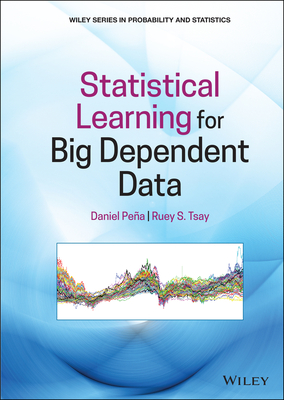Time Series Analysis and Forecasting, 2/e (Hardcover)
暫譯: 時間序列分析與預測(第二版)
Lon-Mu Liu
- 出版商: Scientific Computing
- 出版日期: 2009-04-01
- 售價: $2,625
- 貴賓價: 9.5 折 $2,494
- 語言: 英文
- 頁數: 578
- 裝訂: Hardcover
- ISBN: 0976505681
- ISBN-13: 9780976505686
-
相關分類:
Data-mining
立即出貨(限量) (庫存=1)
相關主題
商品描述
This book is written in a manner which is suitable for a two-semester course in applied time series analysis and forecasting. It can be used in a one-semester course by excluding more advanced topics in the later chapters. The material is targeted to advanced undergraduate and graduate level students in various fields of study (e.g., business, economics, statistics, engineering, medicine, social sciences, environmental sciences, politics, etc.). With its emphasis on practicality and applicability of methodologies, the book is also useful as a reference source for researchers and practitioners in time series analysis and forecasting. While traditional Box-Jenkins methodology emphasizes the exploration and exploitation of serial correlation in time series, the progressive topics on modeling automation, outliers, heteroscedasticity, and nonlinearity are also of great importance. This book places greater emphasis on these newer issues as well as multivariate approaches in time series analysis and forecasting.
Chapters 2 and 3 cover traditional Box-Jenkins ARIMA methodology for non-seasonal and seasonal time series. These two chapters discuss a vast amount of material in a concise manner. In Chapter 4, an effective approach is introduced to automate the task of ARIMA model identification. This approach can be used in conjunction with transfer function models (Chapter 5) to accomplish automatic transfer function modeling. The idea of automation in model building can be further extended to vector ARMA models and simultaneous transfer function (STF) models discussed in Chapters 14 and 15.
Systematic and non-systematic disturbances cause difficulties and inaccuracies in time series modeling and forecasting. Chapter 6 addresses systematic disturbances caused by calendar variation in monthly time series. Chapter 7 discusses non-systematic disturbances relevant to intervention analysis and outlier detection. As an application of outlier detection and estimation, data mining on time series is discussed in Chapter 9. For completeness, traditional forecasting methods using exponential smoothing are addressed in Chapter 8.
Chapter 10 discusses the use of power transformation for modeling and forecasting of certain heteroscedastic time series. In Chapter 11, conditional heteroscedastic models are introduced to address analysis for time series with heteroscedasticity in a different manner. This class of models includes the well-known ARCH/GARCH models.
Traditional time series models often assume that the relationships within the series and the relationships between series are linear. This assumption may not always be appropriate. In Chapter 12, time-segmented and value-segmented (threshold) time series modeling is presented for handling such nonlinear or non-homogenous relationships. Additional topics on nonlinear time series models such as TAR models are discussed in Chapter 13.
Univariate ARIMA models can be generalized to cover multivariate time series. The theory and application of vector ARMA models for multivariate time series analysis are discussed in Chapter 14. Similar to vector ARMA models, single-equation transfer function models can be generalized to multi-equation transfer function models for multivariate time series analysis and econometric analysis. The theory and application of simultaneous transfer function (STF) models are discussed in Chapter 15. As a special application of vector ARMA models, a causality test using this class of models is discussed in Chapter 1
商品描述(中文翻譯)
時間序列分析和預測在許多研究和應用領域變得越來越重要。本書的目標是提煉和整合當前的研究成果,形成連貫且易於理解的方法論,並提供一種簡化的時間序列分析和預測方法。
本書的寫作方式適合用於為期兩學期的應用時間序列分析和預測課程。若排除後面章節中的更高級主題,也可用於一學期的課程。這些材料針對各個學科的高年級本科生和研究生(例如商業、經濟學、統計學、工程學、醫學、社會科學、環境科學、政治學等)。本書強調方法論的實用性和適用性,對於時間序列分析和預測的研究人員和實務工作者來說,也是一本有用的參考資料。雖然傳統的 Box-Jenkins 方法論強調對時間序列中序列相關性的探索和利用,但有關建模自動化、異常值、異方差性和非線性的進階主題同樣重要。本書對這些較新問題以及時間序列分析和預測中的多變量方法給予了更大的重視。
第二章和第三章涵蓋了非季節性和季節性時間序列的傳統 Box-Jenkins ARIMA 方法論。這兩章以簡潔的方式討論了大量的材料。在第四章中,介紹了一種有效的方法來自動化 ARIMA 模型識別的任務。這種方法可以與轉移函數模型(第五章)結合使用,以實現自動轉移函數建模。模型建構中的自動化思想可以進一步擴展到第十四章和第十五章中討論的向量 ARMA 模型和同時轉移函數(STF)模型。
系統性和非系統性擾動會在時間序列建模和預測中造成困難和不準確性。第六章針對由於日曆變化而引起的月度時間序列的系統性擾動進行了探討。第七章討論了與干預分析和異常值檢測相關的非系統性擾動。作為異常值檢測和估計的應用,第九章討論了時間序列上的數據挖掘。為了完整性,第八章介紹了使用指數平滑的傳統預測方法。
第十章討論了對某些異方差時間序列進行建模和預測的幾何變換的使用。在第十一章中,介紹了條件異方差模型,以不同的方式處理具有異方差性的時間序列分析。這類模型包括著名的 ARCH/GARCH 模型。
傳統的時間序列模型通常假設序列內部的關係和序列之間的關係是線性的。這一假設並不總是合適的。在第十二章中,介紹了時間分段和數值分段(閾值)時間序列建模,以處理這種非線性或非均質的關係。第十三章討論了非線性時間序列模型的其他主題,例如 TAR 模型。
單變量 ARIMA 模型可以推廣到涵蓋多變量時間序列。第十四章討論了向量 ARMA 模型在多變量時間序列分析中的理論和應用。與向量 ARMA 模型類似,單方程轉移函數模型可以推廣到多方程轉移函數模型,用於多變量時間序列分析和計量經濟分析。第十五章討論了同時轉移函數(STF)模型的理論和應用。作為向量 ARMA 模型的一個特殊應用,第一章討論了使用這類模型的因果檢驗。











